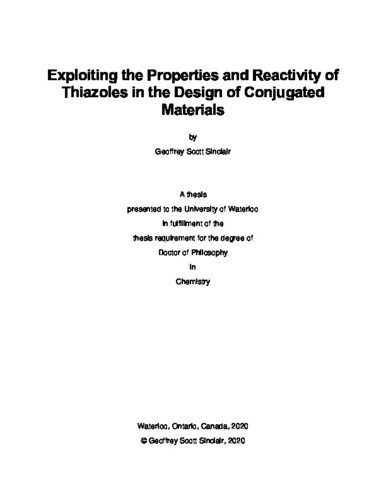| dc.description.abstract | Of fundamental importance to the advancement of next-generation technologies using organic electronic materials is the development of new synthetic methodologies and the investigation of novel material properties. Thiazoles have been reported in conjugated organic molecules and polymers for well over two decades; however, various aspects of these distinct heterocycles have thus far been overlooked and undervalued. This thesis will report our efforts to exploit both the reactivity and properties of thiazole in order to develop new methods for the synthesis of conjugated materials, and to produce conjugated small molecules and polymers with unique properties.
First, our work towards the development of a new transition metal-free condensation reaction for the synthesis of poly(hetero)arenes will be discussed. This reaction utilizes a protecting group strategy, and the unique reactivity of readily accessible thiazole-N-oxides, in order to realize a wide range of bithiazole-N-oxide conjugated small molecules and polymers. In the following section, these bithiazole-N-oxides are explored as a new class of conjugated materials in an extensive joint experimental and computational study. This study revealed a notably strong non-covalent S – O interaction found in the bithiazole-N-oxide core, the effects of which are examined on the optical, electrochemical, and physical properties of the conjugated materials.
Next, the inclusion of alkoxy substituents to the backbone of the conjugated polymer chain, a strategy well-known for poly(thiophene)s, is investigated in bithiazole-containing conjugated polymers. These strong electron-donating groups have been shown to largely decrease the electronic band gaps of the bithiazole polymers, and additionally have allowed for the facile preparation of these polymers through promoting the monomer’s propensity for direct arylation polymerization.
Finally, the reactivity of thiazole-N-oxides is revisited in an attempt to facilitate cross-coupling with electron-rich arenes. Preliminary investigations are described in which a triflic anhydride activation strategy has allowed for the formation of 2-arylthiazoles through the nucleophilic addition of these arenes to thiazole-N-oxide. | en |

